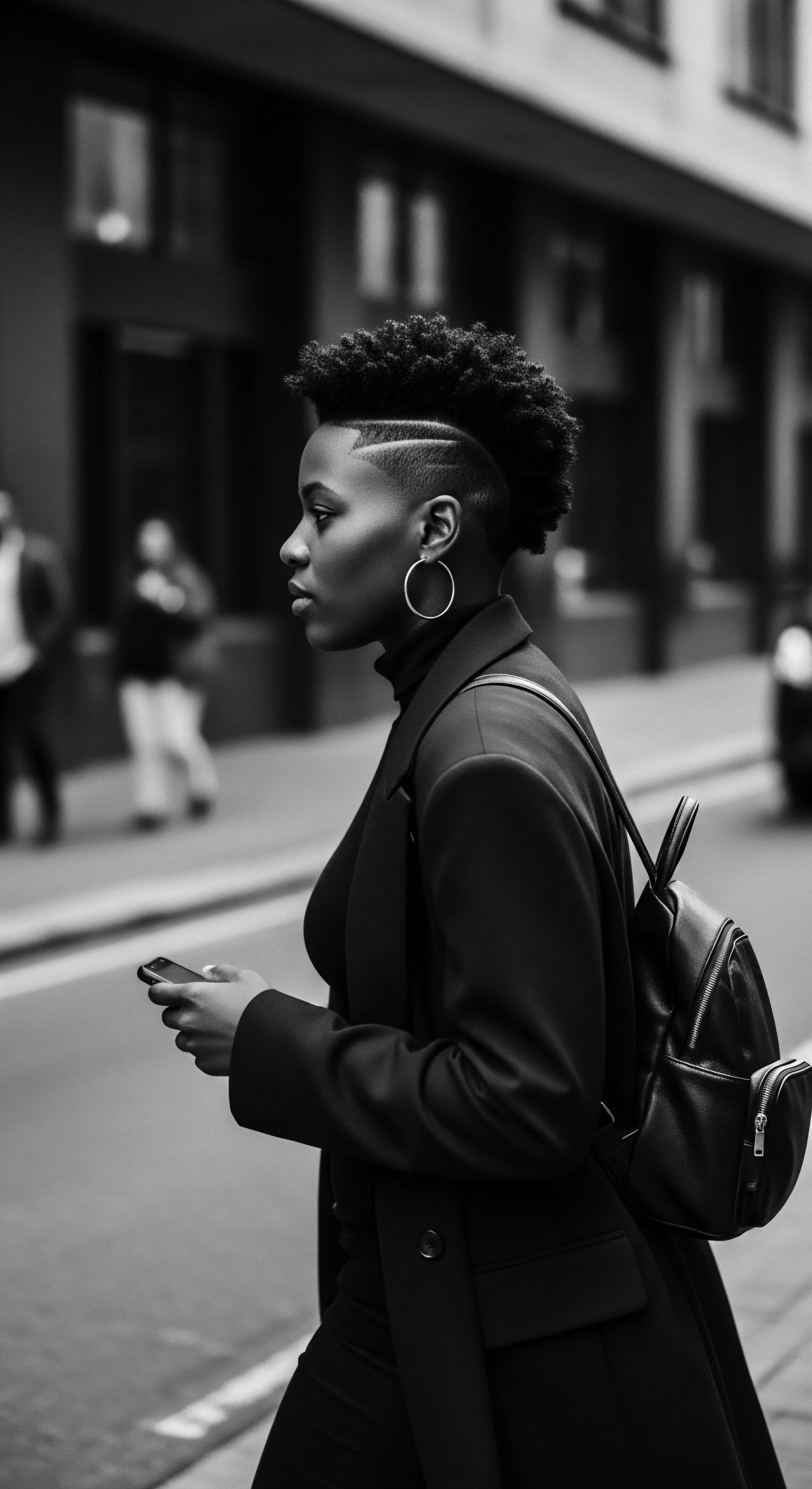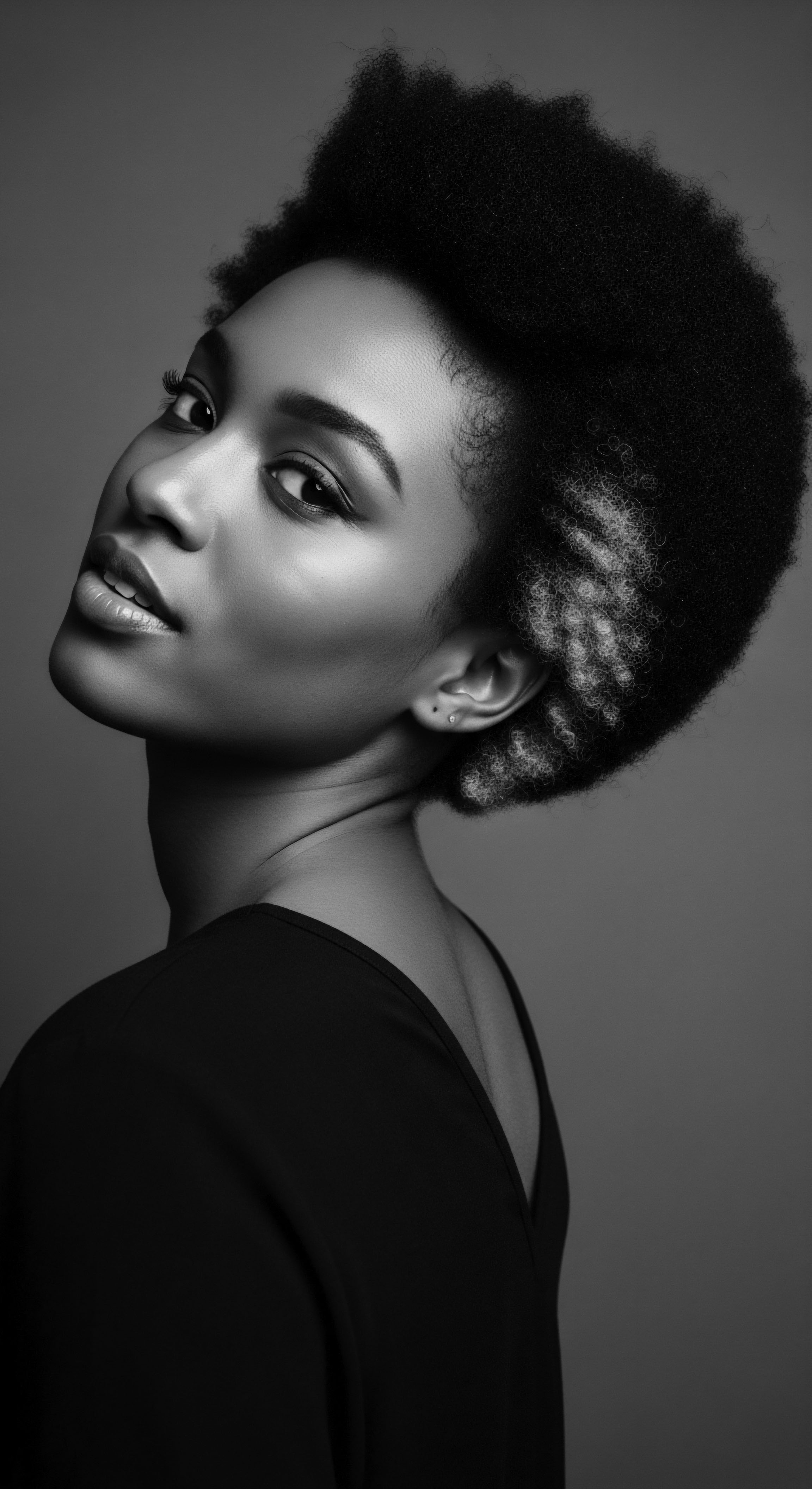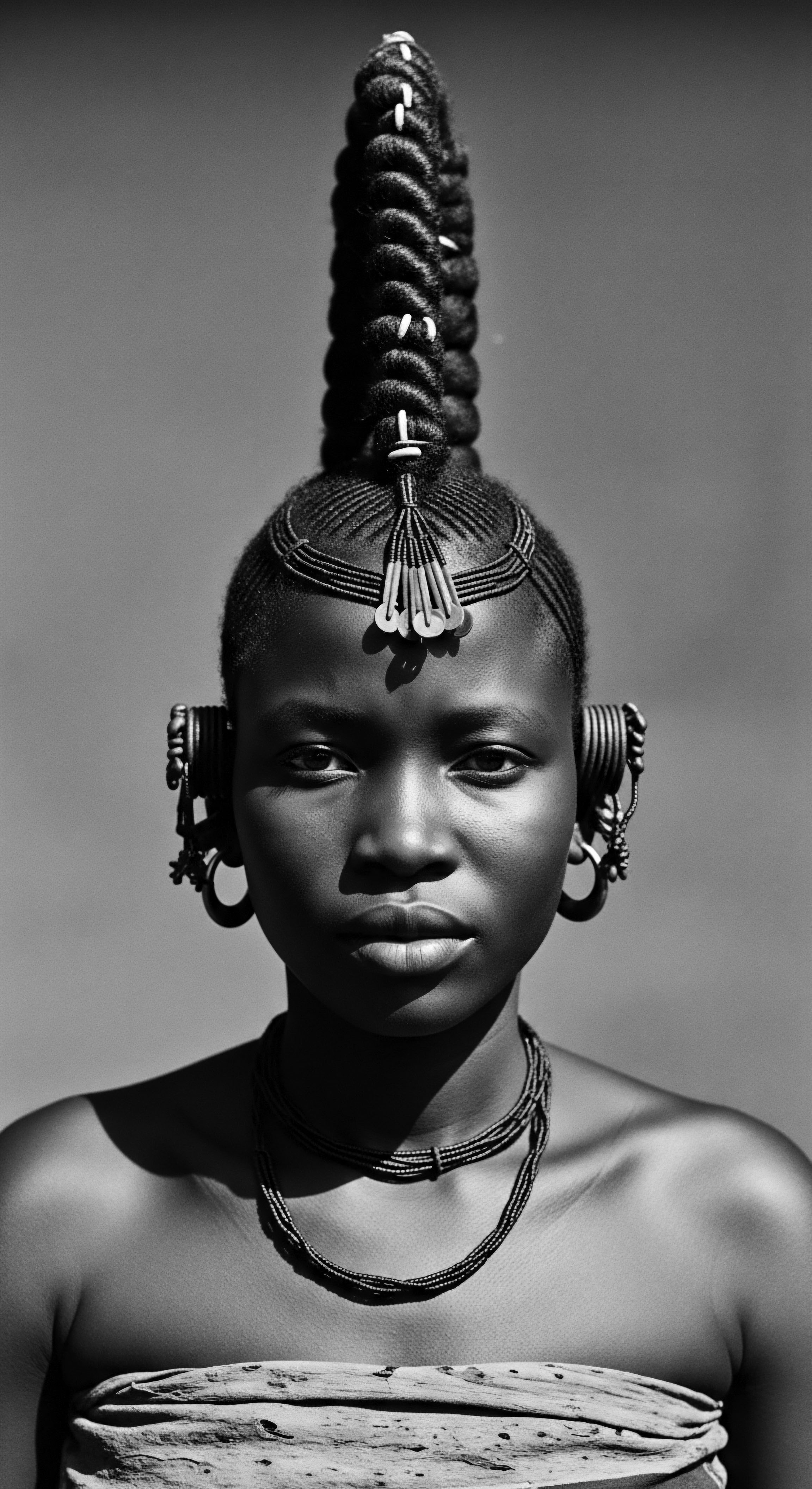
Roots
Consider for a moment the profound intelligence encoded within each twist and turn of textured hair. It is a story, a living archive, held in every coil, a whisper of generations past. For those of us whose lineage flows through the rich currents of African and mixed-race heritage, hair is far more than a simple adornment; it is a profound connection to ancestry, a testament to resilience, and a vibrant canvas of identity. Our very strands carry the memory of sun-drenched lands, of communal rituals beneath ancient trees, and the ingenious ways our forebears coaxed health and vitality from the earth itself.
Within this heritage, the question of how oils reduce friction on textured hair is not a mere scientific inquiry, but an echo from the source, a validation of practices passed down through whispers and skilled hands. It speaks to an inherited wisdom that intuitively understood hair’s unique structure and its vulnerabilities. Friction, that ubiquitous force, is a quiet adversary for textured hair, capable of causing breakage and diminishing its inherent strength.
Each interaction with a dry strand, each gentle pull of a comb, can, without proper care, contribute to a cumulative wear. Here, oils emerge as ancient allies, a soothing balm that protects and preserves.
Understanding the intricate choreography between textured hair and the application of oils requires looking at the strand not as a singular filament, but as a complex biological tapestry. Textured hair, with its diverse array of curl patterns—from broad waves to tightly packed coils—possesses a distinct architecture. The hair shaft, composed primarily of Keratin, is covered by an outer layer of overlapping scales, the Cuticle. In straight hair, these cuticle scales lie relatively flat.
However, in textured hair, the very bends and curves of the strand mean these scales are often naturally raised, making them more susceptible to catching on adjacent strands or external forces. This elevated cuticle creates a higher potential for friction during everyday activities like washing, detangling, or even simply moving the head against a pillow.

How Hair Structure Welcomes Oils?
The genius of oils lies in their ability to lubricate this intricate landscape. When applied, oils form a thin, protective film over the hair shaft. This film acts as a buffer, creating a slippery surface that reduces the direct contact and subsequent rubbing between individual hair strands.
It allows hair to glide past itself and through tools with less resistance, minimizing the mechanical stress that can lead to cuticle damage and eventual breakage. This reduction in friction is particularly critical for textured hair, where the inherent structural characteristics increase the likelihood of inter-strand abrasion.
Oils create a protective, slippery film on textured hair, reducing inter-strand friction and preserving the delicate cuticle layer.
Beyond surface lubrication, certain oils possess the remarkable ability to penetrate the hair shaft itself, offering deeper protection. Research indicates that oils composed of Saturated Fatty Acids and those with shorter, straighter carbon chains penetrate hair more readily than unsaturated or longer-chain fatty acids. Coconut oil, for instance, contains a high concentration of Lauric Acid, a saturated fatty acid with a small molecular structure. This allows coconut oil to effectively absorb into the hair cortex, reducing the amount of water the hair absorbs and preventing protein loss.
When hair absorbs too much water too quickly, it swells, forcing the cuticle scales to stand up and making them vulnerable to damage. By penetrating the hair, oils make the hair proteins more Hydrophobic, or water-repelling, maintaining the hair’s integrity and strength. This deep penetration both fortifies the hair from within and contributes to a smoother exterior, further contributing to a reduction in friction.

What is the Traditional Language of Hair Care?
Ancestral communities, without the benefit of microscopes or molecular spectrometry, observed these effects firsthand. They spoke a language of healthy hair through its suppleness, its resistance to breakage during styling, and its overall luster. This experiential knowledge informed the meticulous selection and application of natural oils and butters for centuries. The traditional terms for specific hair conditions, for the efficacy of certain plant extracts, and for the communal rituals of hair care all reflect an intuitive understanding of the hair’s needs and how natural emollients addressed those needs.
From the West African practice of using shea butter to moisturize hair in hot, dry climates to ancient Egyptian uses of castor and almond oils for hair growth and conditioning, the application of oils was a cornerstone of hair wellness. These practices were not random acts; they were informed by generations of observation and cultural wisdom, recognizing the inherent fragility of textured hair and the protective power of plant-derived emollients.
| Traditional Oil or Butter Shea Butter (Vitellaria paradoxa) |
| Ancestral Observation (Heritage Link) Used in West Africa for centuries to protect hair from harsh environmental conditions, moisturize, and keep hair healthy; considered a sacred symbol. |
| Modern Scientific Understanding (Friction Reduction) Rich in fatty acids like stearic and oleic acid, providing a protective coating that reduces friction and moisture loss. |
| Traditional Oil or Butter Coconut Oil (Cocos nucifera) |
| Ancestral Observation (Heritage Link) Widely used in various African cultures for hair health, shine, and manageability; part of age-old hair care traditions. |
| Modern Scientific Understanding (Friction Reduction) High lauric acid content allows deep penetration into the hair shaft, reducing protein loss and water absorption, thereby increasing flexibility and reducing friction-induced breakage. |
| Traditional Oil or Butter Jojoba Oil (Simmondsia chinensis) |
| Ancestral Observation (Heritage Link) Embraced during the 1970s Black is Beautiful movement as an alternative to Eurocentric products; valued for addressing dryness and breakage in textured hair. |
| Modern Scientific Understanding (Friction Reduction) Chemically similar to natural scalp sebum, it coats hair strands for lubrication, reduces frizz, and moisturizes without heavy residue, aiding in easier detangling and less friction. |
| Traditional Oil or Butter Castor Oil (Ricinus communis) |
| Ancestral Observation (Heritage Link) Used in ancient Egyptian beauty regimens to promote hair growth and for general hair health. In West Africa, oils from similar fatty acid content have been used to prevent breakage. |
| Modern Scientific Understanding (Friction Reduction) A thick oil that coats hair, providing a substantial lubricating barrier, reducing friction during manipulation, and supporting overall hair strength. |
| Traditional Oil or Butter These ancestral emollients reveal a deep, living understanding of hair's needs, predating modern science, yet validated by it. |

Ritual
The touch of oiled hands on textured hair is more than a simple act of application; it is a ritual, a tender thread connecting present care to ancestral wisdom. In countless Black and mixed-race communities across the diaspora, hair care has long been a communal affair, a sacred moment of bonding, storytelling, and the transmission of heritage. Oiling hair was, and remains, a central part of this collective experience, a silent language spoken between generations. The tangible benefits of oils in reducing friction were undoubtedly recognized and celebrated within these living traditions.
Consider the historical reality of styling textured hair. Before the advent of modern tools, fingers, wide-tooth combs carved from wood or bone, and patient hands were the primary implements. Without the smooth glide afforded by oils, these processes would have been fraught with resistance, leading to discomfort and breakage.
The systematic application of oils transformed these potentially damaging interactions into acts of care and preservation. Oiling the hair before detangling, during braiding, or as a finishing touch for twist-outs made manipulation less stressful, allowing for the creation of intricate, protective styles that have served as both adornment and cultural markers for millennia.

How Ancestral Practices Minimized Hair Damage?
The act of oiling was integral to minimizing mechanical damage during everyday grooming. Textured hair, by its very coiled nature, is more prone to tangling and knotting. Dry manipulation can cause the hair’s raised cuticle scales to interlock, leading to tearing and splitting of the hair shaft. Oils counteract this by providing “slip,” a term rooted in experiential understanding long before it found its way into scientific literature.
This slip allows fingers and styling tools to glide through the hair, reducing the snagging and pulling that contribute significantly to friction-induced damage. The historical continuity of this practice, whether using rich shea butter in West Africa or lighter oils in other regions, speaks to its efficacy across diverse textured hair types within the diaspora.
Oils provide crucial “slip,” enabling gentle detangling and styling, a practice deeply ingrained in ancestral hair rituals.
A powerful historical example of oils serving a dual purpose of hair protection and cultural expression can be found in the hair practices of enslaved African people in the Americas. Stripped of their languages, families, and many cultural practices, hair became a profound site of resistance and identity. In the harrowing conditions of forced labor, hair often became matted and tangled. Yet, even in the face of dehumanization, enslaved individuals found ways to care for their hair, often using whatever natural emollients were available—animal fats, vegetable oils, or indigenous plant extracts.
These applications were not merely cosmetic; they were acts of survival. They made the hair more manageable, preventing the severe matting that could lead to pain and forced shaving, a deeply traumatic act of cultural erasure. Hair, softened and made more pliable by these makeshift oils, could be braided and styled in ways that covertly communicated messages, preserved seeds, or even mapped escape routes. The use of oils, therefore, was intertwined with acts of defiance and the silent preservation of selfhood.

What is the Cultural Significance of Oiling Hair?
- Communal Bonding ❉ In many African societies, hair grooming was a shared activity, strengthening familial and community ties. Oiling sessions became moments for storytelling, teaching, and shared laughter, passing down not just techniques but also a sense of collective identity.
- Protective Styling ❉ Oils facilitated the creation and maintenance of styles like braids, twists, and cornrows, which were both functional—protecting the hair from environmental elements and manipulation—and symbolic, conveying status, age, and spiritual beliefs. The oil’s friction-reducing property was central to forming these styles without causing damage.
- Symbol of Resilience ❉ For centuries, particularly through the transatlantic slave trade and its aftermath, the ability to maintain and adorn textured hair with oils represented an act of self-care and cultural continuity against oppressive forces. It was a quiet assertion of dignity.

Relay
The journey of textured hair, from its elemental biological blueprint to its powerful expression of identity, finds a compelling point of convergence in the role of oils. This understanding, once rooted in ancestral observation, now finds validation and deeper explanation through contemporary scientific inquiry. The very friction we seek to mitigate speaks to the unique needs of hair that coils and bends, hair that has traversed continents and centuries, carrying within it the stories of the unbound helix.
Beyond the immediate sensation of slip, the long-term benefits of oils in reducing friction extend into the realm of holistic hair wellness. When mechanical friction is minimized, the hair cuticle remains smoother and more intact. This preservation of the cuticle is paramount for textured hair, as a healthy cuticle means better moisture retention and stronger strands overall.
Oils, by forming a protective layer, help seal the hair’s outer layer, preventing excessive water loss, which can lead to dryness and brittleness. Dry, brittle hair is inherently more susceptible to breakage from friction.

How Do Oils Function on a Molecular Level?
Delving into the molecular architecture, oils are composed of Triglycerides, which are essentially a glycerol backbone with three fatty acid chains attached. The length and saturation of these fatty acid chains dictate how an oil interacts with the hair shaft. Oils with smaller, more linear fatty acids, such as Lauric Acid (found in abundance in coconut oil), can actually penetrate the hair’s cuticle and enter the cortex. This deep penetration offers internal lubrication and strengthens the hair’s protein structure, reducing its propensity to swell excessively with water.
Hair that is properly moisturized from within is more pliable and less likely to break under stress, including frictional forces. Conversely, oils with longer, more branched fatty acid chains, or those that are primarily composed of unsaturated fats, tend to sit more on the surface of the hair, providing an external lubricating film. Both types of action contribute to friction reduction ❉ internal strength and external glide.
Oils reduce friction by both surface lubrication and, for some, deep penetration, strengthening hair from within.
A scientific review published in the Journal of Drugs in Dermatology (Phong et al. 2022) highlighted the efficacy of coconut oil, specifically noting its ability to reduce hair breakage by 41.8%, alongside improving scalp hydration and minimizing protein loss and water absorption. This statistical evidence underscores the powerful, measurable impact of traditional oiling practices on the physical resilience of textured hair. The study, which included a significant proportion of patients with skin of color, validates generations of lived experience and ancestral knowledge regarding the benefits of oils.

What is the Role of Oils in Nighttime Care?
The wisdom of ancestors also recognized the need for care during periods of rest. Nighttime rituals, often involving the application of oils and the use of head coverings, serve as a profound example of anticipating and mitigating friction. While sleeping, hair often rubs against rough fabrics, such as cotton pillowcases, which can create significant friction, leading to tangles, breakage, and loss of moisture. The practice of oiling the hair before bed, followed by wrapping it in silk or satin, or covering it with a bonnet or scarf, creates a smooth, low-friction environment.
This protective cocoon allows the oils to continue their work of conditioning and sealing, minimizing the mechanical stress of tossing and turning, and preserving the hair’s delicate structure through the night. The bonnet, a ubiquitous symbol of Black hair care, is a modern iteration of ancestral head wraps, both serving as vital barriers against nightly friction and a means of preserving intricate hairstyles for days on end.
The continuity of oiling practices, from ancient traditions to contemporary regimens, speaks to their enduring effectiveness in nurturing textured hair and sustaining its health against frictional wear. This legacy allows for an understanding of hair care that moves beyond superficial styling to a deeper appreciation of the hair’s vitality and its unbreakable connection to heritage.

Reflection
The understanding of how oils reduce friction on textured hair is a narrative woven through time, a testament to the profound relationship between people of African and mixed-race descent and their hair. From the intuitive wisdom of our earliest ancestors who recognized the soothing power of plant-derived emollients to the rigorous scientific validations of today, the story of oils and textured hair is one of continuity and deep connection. It speaks to a legacy of ingenuity, resilience, and self-preservation in the face of adversity.
Each drop of oil applied is an echo of hands that have tended, nurtured, and affirmed the inherent beauty of our strands through generations. This enduring heritage, the Soul of a Strand, reminds us that the care of textured hair is not merely a regimen; it is a living, breathing archive of identity, culture, and an unwavering spirit.

References
- Byrd, A. D. & Tharps, L. I. (2001). Hair Story ❉ Untangling the Roots of Black Hair in America. St. Martin’s Press.
- Phong, C. Lee, V. Yale, K. Sung, C. & Mesinkovska, N. (2022). Coconut, Castor, and Argan Oil for Hair in Skin of Color Patients ❉ A Systematic Review. Journal of Drugs in Dermatology, 21(7), 751-757.
- Afoakwa, E. O. Budu, A. S. & Ofori, L. (2024). An Exploration of The Cultural Symbolism of Some Indigenous Cosmetic Hair Variants in The Dormaa Traditional Area, Ghana. African Journal of Applied Research, 10(2).
- Rele, J. S. & Mohile, R. B. (2002). Effect of mineral oil, sunflower oil, and coconut oil on prevention of hair damage. Journal of Cosmetic Science, 54(2), 175-192.
- Dias, M. F. R. (2015). Hair Cosmetics ❉ An Overview. International Journal of Trichology, 7(1), 2–15.
- Byrd, A. D. & Tharps, L. I. (2014). Hair Story ❉ Untangling the Roots of Black Hair in America (Revised Edition). St. Martin’s Griffin.
- Robbins, T. R. & Byrd, A. D. (2004). Hair. The Greenwood Encyclopedia of African American Culture and History ❉ The Black Experience in America, 109-112.
- White, S. & White, G. (1995). Slave Hair and African American Culture in the Eighteenth and Nineteenth Centuries. The Journal of Southern History, 61(1), 1-28.
- Jacobs-Huey, L. (2006). The Aura of the “After” in African American Women’s Talk about Hair. Ethos, 34(3), 369-397.
- Rooks, N. M. (1996). Hair Raising ❉ Beauty, Culture, and African American Women. Rutgers University Press.
